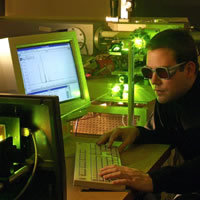
Research
Lower Saxony's research landscape, with its outstanding higher-education establishments and non-university research institutions, has a great deal to offer. The area known as the 'research triangle' – encompassing Brunswick, Göttingen and Hannover – is one of Europe's most eminent regions for research and development.
Under Germany's Excellence Initiative, which funds innovative research projects and outstanding institutions, the University of Göttingen has (unofficially) been awarded the status of one of the country's leading research universities. Clusters of Excellence have been established at the University of Göttingen (in biomedicine), the University of Hannover (in physics) and Hannover Medical School (MHH; in regenerative medicine), along with graduate schools at the University of Göttingen (for the neurosciences) and MHH (for biomedicine).
Lower Saxony has 13 universities and seven other higher-education establishments. All of them have developed their own priority research fields – from the natural sciences and engineering to the humanities. The state's research landscape is also characterized by a significant number of non-university research institutions. These include the various institutes of the Max Planck Society, the Fraunhofer Society and the Leibniz Association, the centres of the Helmholtz Association, and a number of independent federal-state research institutes.
Among the hallmarks of research in Lower Saxony are its outstanding quality – evident in, for example, the participating institutions' great success in acquiring external funding – and the wide range of disciplines involved. In order to achieve this, cooperation is essential. Increasingly, therefore, the state government is funding joint projects that bring together partners from non-university research institutes and universities. This funding policy has led to Lower Saxony's present-day reputation for expertise in areas such as the life sciences and renewable energies. The federal state has also promoted collaborations between science and industry for a number of years, especially in automotive engineering.




 deutsch
deutsch english
english français
français español
español nederlands
nederlands plattdüütsch
plattdüütsch русский
русский polski
polski 中文
中文 日本語
日本語